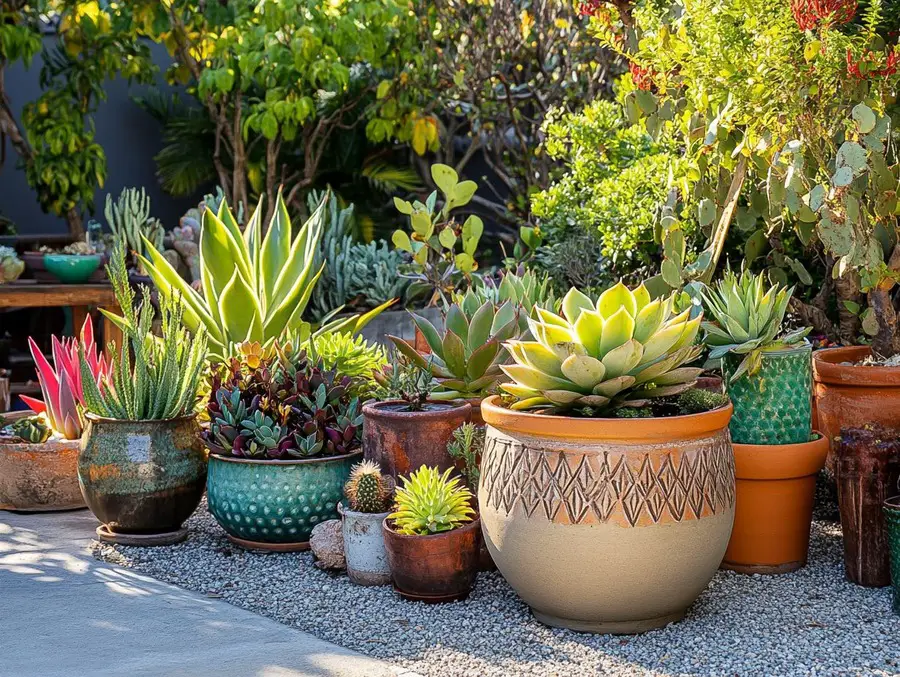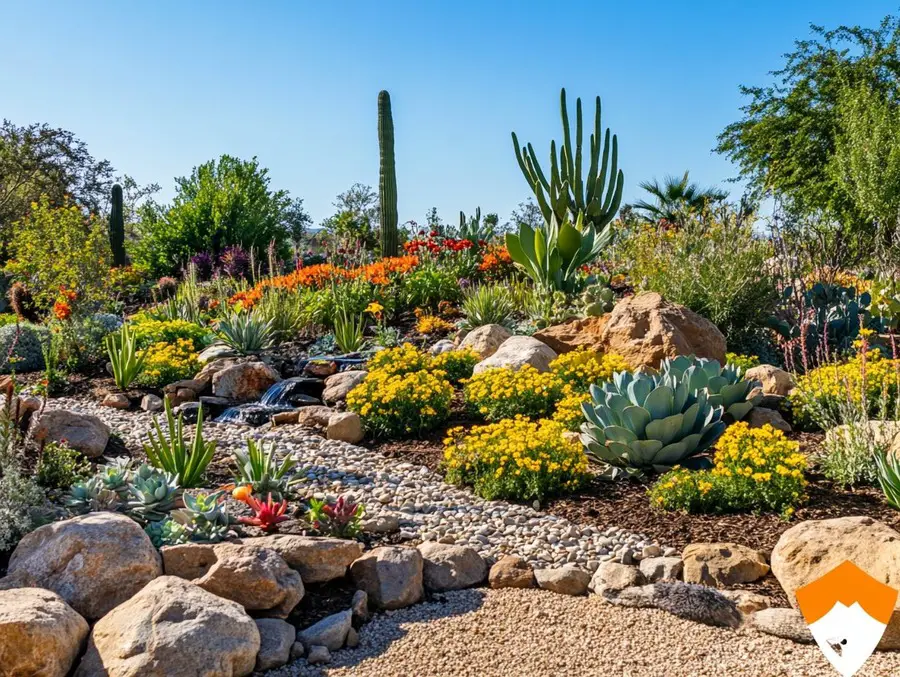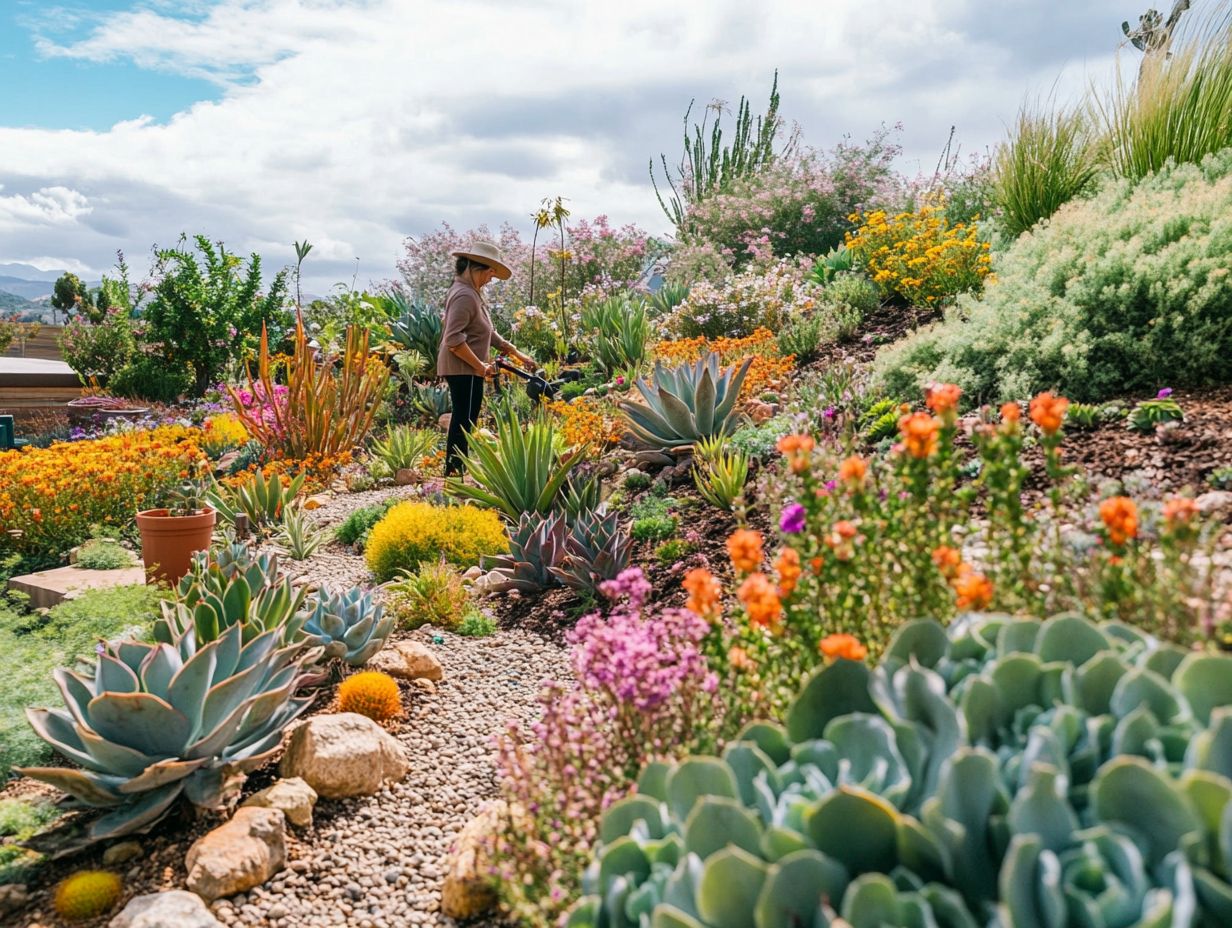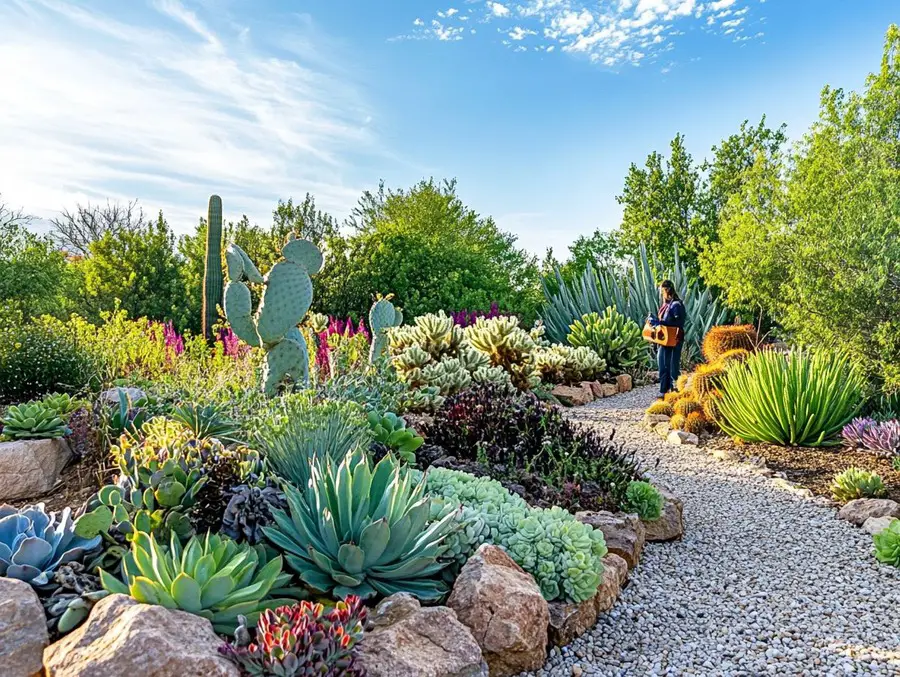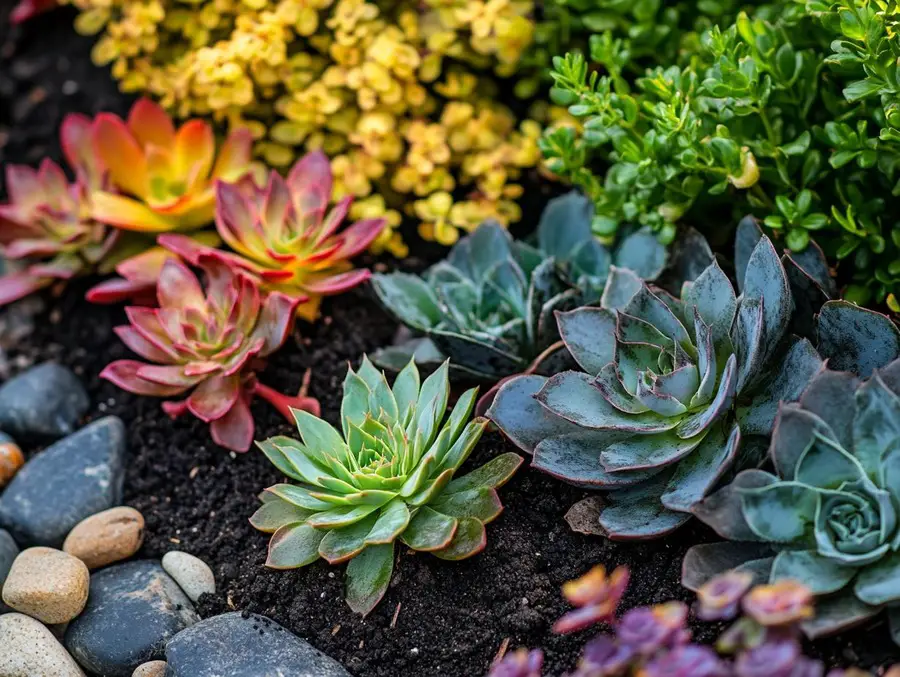We use affiliate links. If you purchase something using one of these links, we may receive compensation or commission.
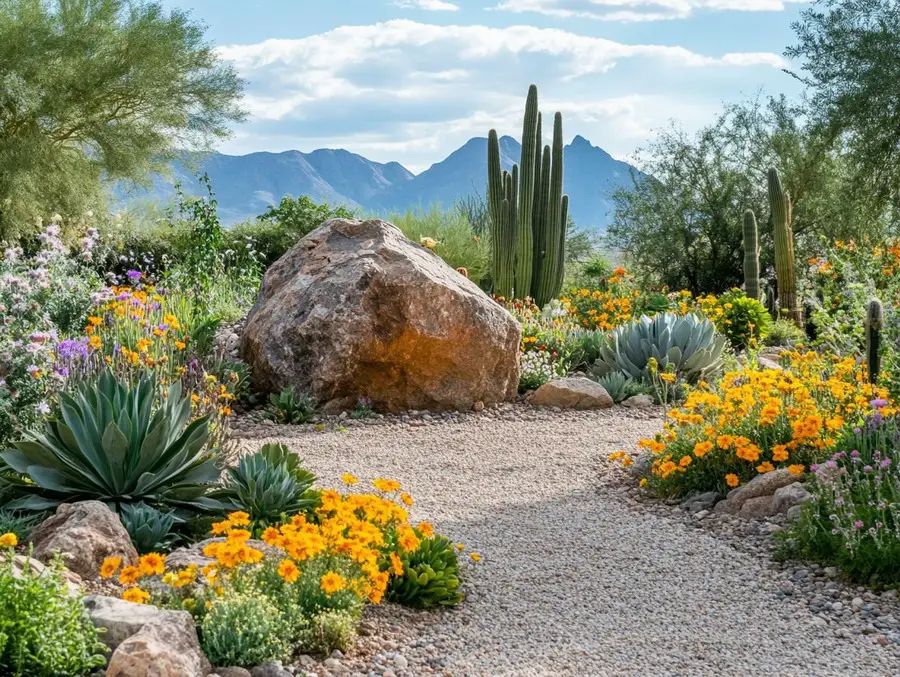
Adding character to your xeriscape isn’t just about plants, it’s also about creating focal points in xeriscaping that draw the eye and add personality.
Without them, your landscape might feel scattered or incomplete.
By incorporating striking plants, unique hardscape elements, or artistic features, you can transform your yard into a visually stunning and functional space.
Focal Points in Xeriscaping
Key Takeaways
- Focal points in xeriscaping enhance visual appeal and guide the eye through a landscape.
- These can include standout plants, sculptures, water features, or unique hardscape elements.
- Proper placement creates balance and interest while maintaining water efficiency.
- Choosing drought-resistant plants and eco-friendly materials ensures a sustainable and striking design.
Creating Focal Points in Xeriscaping: Transform Your Space
Xeriscaping is a sustainable landscaping approach that helps you conserve water while making your outdoor space more beautiful.
One of the key elements that can really elevate your xeriscape design is the strategic use of focal points.
These unique features boost the aesthetics of your yard and improve its functionality.
In the following sections, you’ll discover how to choose and create eye-catching focal points using plants and hardscape elements, along with some handy tips for keeping them looking great for years to come.
So, dive into the world of xeriscaping and see how you can turn your landscape into a stunning oasis!
What is a Focal Point in Xeriscaping?
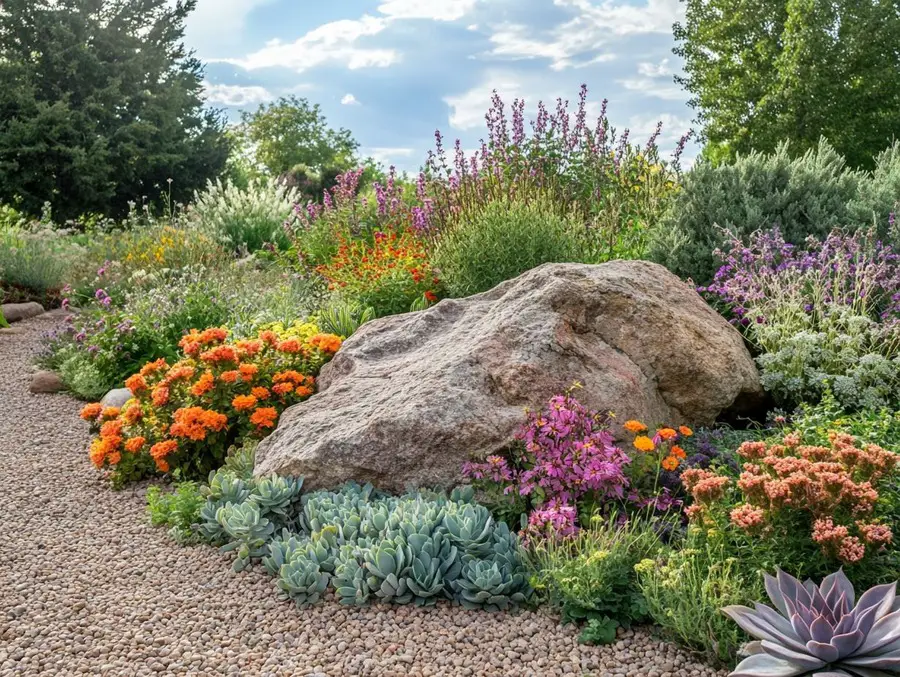
Xeriscaping is a brilliant way to garden sustainably, making it easier for you to reduce the need for irrigation by using drought-resistant plants and eco-friendly practices.
This landscaping method works wonders, especially in arid climates, where conserving water is crucial for keeping your outdoor space looking great.
The essence of xeriscaping is all about picking plants that are naturally suited to your local conditions.
This helps them thrive and also cuts down on the need for chemical fertilizers and pesticides.
Understanding the different soil types you have, along with their drainage properties, is super important.
It can really shape your plant choices and the overall health of your garden.
When you put xeriscaping principles into action, you’re not just creating a beautiful landscape.
You’re also contributing to environmental sustainability by reducing water use and promoting healthier soil.
By planting a diverse array of plants, you’re inviting pollinators into your garden and building resilience against pests.
The result? A thriving landscape that’s as ecologically sound as it is gorgeous.
Benefits of Focal Points in Xeriscaping
Incorporating focal points in your xeriscaping isn’t just about making your garden look good.
It also boosts its overall functionality, turning your outdoor spaces into something truly engaging and enjoyable.
Focal points catch the eye, creating a sense of unity and guiding visitors through your beautifully designed landscape.
By strategically placing elements like rocks, sculptures, cozy seating areas, and unique plant groupings, you can elevate your garden design, adding depth and richness to the outdoor vibe while promoting biodiversity and sustainable practices.
This approach lets you play with seasonal planting and texture contrasts so your garden stays vibrant and interesting all year round.
Enhancing Aesthetics and Functionality
Enhancing both the look and functionality of your xeriscaped garden is key to creating an inviting and practical outdoor space.
By applying design principles like layering, color schemes, and texture contrast, you can achieve that perfect balance that speaks to the senses.
Adding garden features such as pathways, seating areas, and water elements can create a tranquil atmosphere while encouraging exploration throughout your landscape.
Considering seasonal interest and planting a diverse range of xeric plants helps keep your garden visually engaging all year round, boosting its overall charm.
To really impress with your xeriscaped garden, think about strategically placing focal points, like a beautifully ornate birdbath or a striking sculpture, to catch the eye and lead people through the space.
Mixing up plant heights adds depth and dimension while ensuring that ground cover and lower plants are visible.
By implementing a carefully curated color palette, you can significantly influence the mood, whether you go for vibrant blooms or serene neutrals, it all helps to establish harmony.
These design elements amp up the outdoor aesthetics and also promote a sense of relaxation and connection to nature that you’ll really appreciate.
Choosing Focal Points for Your Xeriscape
Choosing focal points for your xeriscape is a crucial part of garden design that really impacts the overall visual balance and outdoor aesthetics.
When you’re picking these focal points, think about incorporating architectural elements like arbors or trellises.
They can serve as eye-catching anchors in your landscape.
You might also want to add unique sculptures or vibrant flower beds to draw attention and create a sense of unity throughout your garden.
And don’t forget about seasonal changes! Make sure your plant selections keep your focal points looking great and contribute to a cohesive design all year round.
Factors to Consider
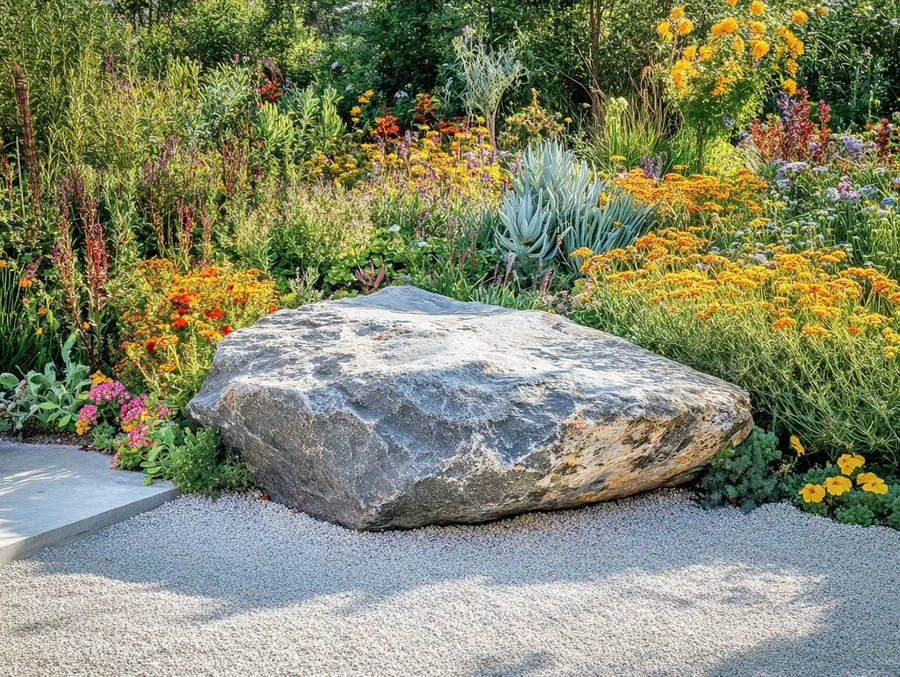
When you’re picking focal points for your xeriscape, there are a few important factors you’ll want to keep in mind to make sure everything thrives and looks great in your landscape.
Sunlight exposure is key here. It’ll really help determine which drought-resistant plants and garden features you choose.
The right light conditions are crucial for plant health and visual appeal.
Think about how well the plants adapt to your climate and how you manage your soil to create a balanced environment that supports biodiversity.
Including pollinator-friendly plants and potential wildlife habitats can really enrich your outdoor space.
Water availability is another biggie. Setting up efficient irrigation systems or rainwater harvesting can keep your plants happy and healthy without wasting water.
Pay attention to how you arrange these focal points because you want a natural flow and balance so the larger elements don’t steal the spotlight from the smaller ones.
Don’t forget about practical maintenance! Making sure you have easy access to pruning and weeding will play a big role in the long-term success of your xeriscaping project.
Ultimately, if you take a thoughtful approach that aligns environmental conditions with your aesthetic choices, your design will flourish and stay sustainable throughout the seasons.
Creating Focal Points with Plants
Creating focal points with plants is a fun way to add beauty and interest to your xeriscape while also promoting biodiversity and seasonal flair.
By carefully considering your plant selection, you can incorporate vibrant flowering species, ornamental grasses, and succulents to craft dynamic visual pathways that guide visitors through your garden.
Grouping plants with contrasting colors, textures, and heights makes for an inviting atmosphere.
This approach lets you enjoy seasonal planting, keeping your garden lively and fresh all year round.
Strategic Plant Placement and Selection
Strategic plant placement in your xeriscape means picking xeric plants that thrive in your local garden zones and also doing their part for the environment.
By thinking about their growth habits and sunlight needs, you can create a landscape that’s beautiful and ecologically sound.
Incorporating native plants boosts your garden’s environmental impact, helping local wildlife and promoting biodiversity while keeping your focal points visually appealing.
When you’re aiming for successful xeriscaping, it’s essential to understand the specific growth habits of the plants you choose.
This knowledge will guide you in how they interact regarding space and light requirements.
With this insight, you can place your plants thoughtfully, minimizing competition for resources and leading to a healthier garden overall.
Keeping local garden zones in mind will help you select species that are well-adapted to your region’s climate and soil conditions, making your garden more sustainable.
Embracing this knowledge simplifies maintenance and nurtures a thriving ecosystem where each plant has its role, adding to the overall charm of your xeriscaped area.
Incorporating Hardscape Elements
Incorporating hardscape elements into your xeriscape can really elevate the look of your outdoor space while also adding functional benefits that complement your plant choices.
Think about adding features like patios, pathways, and retaining walls.
They create visual pathways that guide visitors through your garden and add some structure and contrast to the natural elements.
If you choose eco-friendly materials for your hardscape, you’ll be aligning your design with sustainable gardening principles.
That way, your landscape can be both responsible and stunning!
Using Non-Plant Features as Focal Points
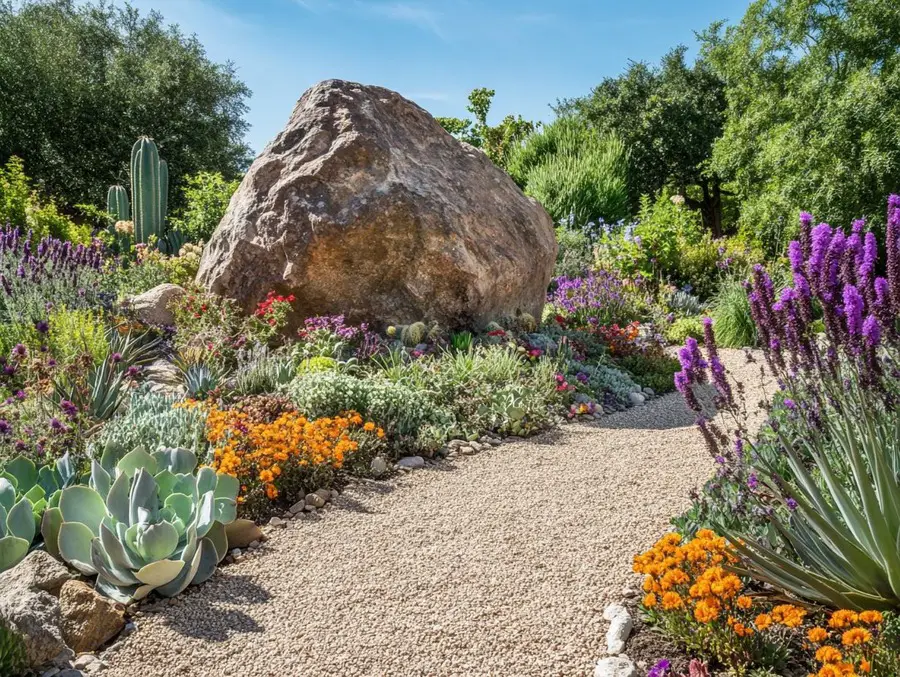
Using non-plant features as focal points is a clever way for you to add character and charm to your xeriscape while complementing your plant selections.
By thoughtfully incorporating elements like decorative stones, water features, or uniquely designed pathways, you can guide visitors through your space and enhance their overall experience.
These practical design choices serve as eye-catching accents and help establish a cohesive theme that reflects your personal style.
For example, a beautifully crafted stone bench or a whimsical birdbath can be both artistic additions and functional spots for relaxation or observing wildlife.
Ultimately, integrating these non-plant features elevates your outdoor landscape, making it not just visually appealing but also a versatile area for social interaction and leisure.
Maintaining Focal Points in Xeriscaping
Keeping focal points in your xeriscape is key to creating a vibrant and appealing landscape that stays interesting all year round.
Regular garden maintenance, like pruning, managing the soil, and planting seasonally, will help your focal points shine while also supporting the overall health of your plants.
If you add efficient irrigation systems, you can cut down on water use while keeping your drought-resistant plants thriving.
This way, you get to enjoy a beautiful garden without the heavy lifting!
Tips for Long-Term Care and Upkeep
For the long-term care and upkeep of your xeriscape, it’s essential to get to know your soil types, irrigation needs, and the specific requirements of your garden features.
By regularly checking in on the health of your drought-resistant plants and making any necessary adjustments, you’ll create a thriving landscape that aligns with your environmental sustainability goals.
Using eco-friendly practices and keeping an eye on how your garden performs will help you maintain a beautiful outdoor space that meets both your aesthetic desires and ecological responsibilities.
To boost your soil quality, think about performing regular tests to check pH levels and nutrient content. This way, you can make informed amendments.
Mulching is another great tip because it conserves moisture and suppresses weeds, which is super important in a xeriscaped environment.
Don’t forget to embrace drip irrigation systems for efficient water delivery.
This minimizes evaporation while ensuring your plants get deep root hydration.
Incorporating native plants can also make a big difference by reducing the need for fertilizers and pesticides, which helps foster a healthier ecosystem.
Regularly pruning and deadheading will encourage vigorous growth and blooming cycles, making your garden dynamic and visually appealing while promoting biodiversity.
Frequently Asked Questions
What is xeriscaping?
Xeriscaping is a landscaping technique that focuses on conserving water by using drought-resistant plants and minimizing the need for irrigation.
Why is it important to create focal points in xeriscaping?
Creating focal points in xeriscaping helps to add visual interest and draw the eye to certain areas of the landscape, making it more visually appealing.
What are some examples of focal points in xeriscaping?
Some examples of focal points in xeriscaping include using rocks, water features, sculptures, or groupings of plants with contrasting colors or textures.
How can I create a focal point in my xeriscaped yard?
You can create a focal point in your xeriscaped yard by using plants with bold colors or interesting shapes, incorporating a unique hardscape element, or adding a seating area or fire pit.
What are some things to consider when creating focal points in xeriscaping?
When creating focal points in xeriscaping, it’s important to consider the overall design of your landscape, the size and scale of the focal point, and how it will fit into the rest of the space.
Can I incorporate focal points into my existing xeriscaping design?
Yes, you can easily add focal points to an existing xeriscaping design by incorporating new elements or rearranging existing plants and features to create a more eye-catching area.
Xeriscape Garden Design & Layout: Easy Water-Wise Beauty
What is xeriscaping? A beginner’s guide to drought-tolerant landscaping
Related Content
Visit my Amazon Influencer Page for videos and gardening products Grow Your Own Garden

